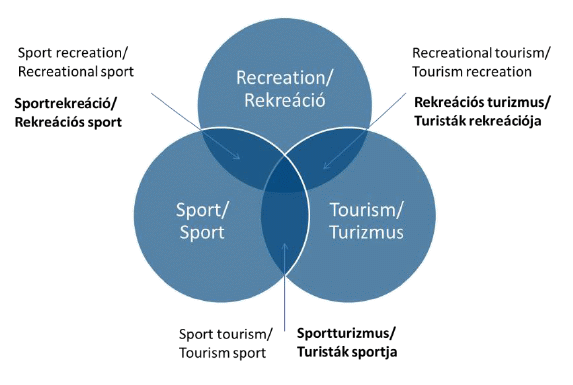II.1. Basic notions
The definitions of recreation, sports and tourism have already been well defined both in Hungarian and international specialist literature, so, I do not intend to detail their specificities. The aim of this work is to emphasize some of their basic characteristics. The term recreation was first used in Hungary at the beginning of the 20th century as the synonym for ’relaxation, holidaymaking, school break, enjoyment’ (Bánhidi 2012), then, at the end of the century its meaning was narrowed down to sports recreation by relating it to health. (Kovács 2002).
According to the current academic terminology the notion of recreation means the culture of spending one’s leisure time, active recreation, wellbeing, joy, the regeneration of one’s working capability, the preservation and improvement of one’s health. Recreation is a kind of positive behavior – individual and social – which is aimed at the formation of people’s somatic, psychological and social wellbeing. (Pigram 1983, Harsányi 1991, Cushman, Laidler 1990, Kovács 2002, Szabó 2006, Gáldi 2011, Bánhidi 2012). As an essence of several of its definitions it can be stated that recreation goes back to people’s natural needs, it is related to culture and leisure time, and it gives experience, and joy. Recreation results in improved physical and psychological conditions. The classification of recreation is based on its main objectives. Its most important categories include outdoor, health preserving, and adventure seeking recreation. (Gáldi 2011). The majority of recreational activities is organized within a group of friends, family members and they are less related to external organizations or facilities. (Kiss G. 2009).
Another feature of recreation that needs to be emphasized is the presence of recreational experience. Its components- among many others - include (Gray (1978) novelty, originality, self-discovery, timeliness, sense of freedom, identification with the activity, rewarding efforts, pleasurable memories and the unity of body and mind.
Sports, according to the European Sports Charter (1992) „Sport means all forms of physical activity which, through casual or organised participation, aim at expressing or improving physical fitness and mental well-being, forming social relationships or obtaining results in competition at all levels.” Sports is an outstanding area of body culture, whch has a beneficial influence on people’s personality as a whole, on their intellectual, social, ethical and emotional charateristics and abilities. (Rétsági 2004). Sports is a physical and emotional defense factor (Pikó, Keresztes 2007). It presupposes and formulates adequate psychomotor abilities, it has regulatory functions. In many cases – but not necessarily always – it is based on competition and requires stamina, risk-taking, playfulness or skilfulness. The systematization of the different types of sports is a difficult task; it can be done on the basis of its medium, the sports equipment, its aim, the number of people, or the traditions. (sportolanemzet.hu). It is fact of interest that the word ’sports’ was ’imported1 from England by Count István Széchenyi and it was originally used in Hungary to denote some entertaining pastime. (Takács 2009).
Tourism means the movement of people to places other than their place of residence and it includes services to meet their needs. There are several different motivations, models and styles, tourism might mean different things for different people. (Kollarik 1991, Fejős 1998). Leisure time tourism is based on the free choice of people; their aim is to be at a place which is different from their homes. They want different experiences, they want to face different challenges, or, on the contrary they need a quite place., or, want to experience some kind of spirituality. These desires – similar to all spatial mobility within society - are induced by some push and pull factors between people’s homes and the chosen destination. The msot significant socio-cultural effects of tourism are manifested in the increase of social and regional mobility as well a sin the incresing prestige of regional and national heritage. (Csordás 2006).
Ont he basis of the above it has become evident that recreation, sports and tourism are not part of a hierarchical system. (Figure 1. ) It is misleading to think that one represents part of the other; . (E.g. tourism is not part of recreation, or, recreation is not part of sports.) All these three areas have properties, which make it necessary to define them as autonomous and independent entities, consequently they are co-ordinates. At the same time, they have common areas which are determined by common goals, similar tools and activities. The model below cannot reflect the entire truth – and this is the nature of models in general – but it does explain its essence. (Haggett p. 22).

Figure 1. The system of relationships between recreation, sports and tourism. Ed. Győri 2013.